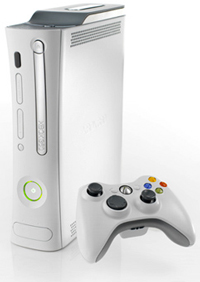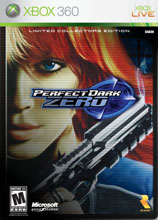Xbox
360: Launch Impressions and System Review
Few events in electronic gaming are as anticipated and over-heated as a
console launch. Occurring rarely, the birth of a new system usually gives
clues as to where the system is headed during its lifespan. Four years
ago, Microsoft entered the gaming community with the original Xbox, an
oversized yet incredibly powerful system. The Xbox was able to overcome
some initial skepticism and earned a solid reputation for its outstanding
Xbox Live service and for bringing PC style gaming to the living room with
little compromise. Now, the software giant has unleashed its follow-up,
Xbox 360 on the market. Join us as we take an in-depth look at the system
and some of its launch software and see what it portends for Microsoftís
second assault.
 A
little over a week has passed since the much-anticipated launch of
Microsoftís Xbox 360. Despite widespread shortages, it appears that the
company finds itself in a much stronger position this time around. A more
mature machine, the new console immediately makes a statement. Itís pure
white finish draws a stark contrast to the first Xbox, with rounded edges
and a smoother face adding to the machineís sleek, high-tech vibe. It
almost looks like an Apple product in many aspects, though the irony
probably hasnít been lost. While the first Xbox slammed its image home
with a giant X that dominated the systemís top, Microsroft has taken a
more subtle path the second time around, with a smoother, simpler design
thatís both elegant and functional. The most interesting aspect of the
design is the circle of life, a round globe of light in the center of the
machine that lights up, and also indicates which controllers are
connected. It might seem like a flashy gimmick, but it compliments the
wireless controllerís functionality perfectly. The wireless controllers
also help the system look cleaner, since the ports are recessed inside the
machine, allowing for a more streamlined appearance. Hiding the USB ports
under the hood also adds to the machineís minimalist aesthetic, giving
itís face a seamless appearance. While in operation, the system radiates
a loud hum, which can be frightening at first, but becomes less annoying
as time goes around. One mis-step is the large power-brick AC Adaptor,
which is nearly as large as the console itself, and is difficult to store
in an out of the way location.
A
little over a week has passed since the much-anticipated launch of
Microsoftís Xbox 360. Despite widespread shortages, it appears that the
company finds itself in a much stronger position this time around. A more
mature machine, the new console immediately makes a statement. Itís pure
white finish draws a stark contrast to the first Xbox, with rounded edges
and a smoother face adding to the machineís sleek, high-tech vibe. It
almost looks like an Apple product in many aspects, though the irony
probably hasnít been lost. While the first Xbox slammed its image home
with a giant X that dominated the systemís top, Microsroft has taken a
more subtle path the second time around, with a smoother, simpler design
thatís both elegant and functional. The most interesting aspect of the
design is the circle of life, a round globe of light in the center of the
machine that lights up, and also indicates which controllers are
connected. It might seem like a flashy gimmick, but it compliments the
wireless controllerís functionality perfectly. The wireless controllers
also help the system look cleaner, since the ports are recessed inside the
machine, allowing for a more streamlined appearance. Hiding the USB ports
under the hood also adds to the machineís minimalist aesthetic, giving
itís face a seamless appearance. While in operation, the system radiates
a loud hum, which can be frightening at first, but becomes less annoying
as time goes around. One mis-step is the large power-brick AC Adaptor,
which is nearly as large as the console itself, and is difficult to store
in an out of the way location.
System aesthetics aside, Xbox 360ís improved controller feels like a
simpler, streamlined version of the Controller-S Microsoft released for
the original console. Microsoft has improved the placement of the buttons,
moving the annoying black and white buttons to the top and relabelling
them as back shift buttons, while maintaining the 4 basic buttons on the
face. Both Analog sticks have returned in approximately the same location,
though they feel a bit sturdier this time around. Unlike the original
controller, which featured a large X with no function, the new controller
includes a new X button in the center of the controller. This has a
variety of uses including turning on the console, and can also be used the
call up the Xbox dashboard at any time, even during play. This makes for a
much more convenient and high-tech solution and allows you to manage your
system effortlessly. The start and select buttons have been moved to
either side of the button as well, making them easier to access. Of
course, having a wireless controller means that it needs to carry
batteries, and the placement of the battery pack on the backside middle of
the controller allows it to have a good sense of balance without becoming
intrusive or hard to manage. The new controller feels a bit heavier, yet
more solid than the Controller-S, giving the player a sturdier grip that
doesnít feel as plastic or flimsy as most gaming controllers on the
market. While the controller isnít flashy and doesnít rely on cheap
gimmicks, its solid form and familiar orientation should make it an
excellent evolution of the Xbox controller.
 While
the hardware is solidly and intelligently constructed, the new systemís
streamlined user interface is also elegant, and easier to navigate while
completely intergrating the machineís multimedia and online features.
Using an intuitive system of blades allows you to quickly move between
game, memory and file management systems. You can use and store a varierty
of files ranging from MP3 to video and more. The console can interact with
a variety of portable devices including i-Pods, digital cameras and even
trade files with the Sony PSP using the USB ports. Players can also manage
their gamer-tags on this menu and can keep track of accomplishments and
tournaments online. One of the more impressive aspects of the system comes
when you look at the Xbox Live Blade, and find the service fully
integrated and playable from the get go. Signing up to the service and
registering your GamerTag should take no time at all, and once connected,
youíll find the service has been fully upgraded with a smoother and even
more versatile appearance thatís even more connected to the console
experience. As an added bonus, several minutes of bonus multimedia content
have been loaded on the 350ís hard-drives, adding value to the system
from the start. In addition, Xbox 360ís DVD playback abilities are
superb as well, and you donít need to purchase a special adaptor this
time around to play them, which is a plus. Sadly, there are a few problems
out of the box that hinder the experience. While the limited backward
compatibility was always going to be a negative factor, the machine ships
with only two emulators Ė one for each Halo title. In order to play any
other original Xbox game, players have to jump through several hoops such
as downloading emulators or purchasing an emulation disc through the Xbox
web-site. This shouldnít be too difficult for most gamers, but is an
annoying process nonetheless. All in all, this is a solid launch from a
hardware point of view, with smartly designed features and outstanding
aesthetics that make Xbox 360 one of the best recent console launches in
memory.
While
the hardware is solidly and intelligently constructed, the new systemís
streamlined user interface is also elegant, and easier to navigate while
completely intergrating the machineís multimedia and online features.
Using an intuitive system of blades allows you to quickly move between
game, memory and file management systems. You can use and store a varierty
of files ranging from MP3 to video and more. The console can interact with
a variety of portable devices including i-Pods, digital cameras and even
trade files with the Sony PSP using the USB ports. Players can also manage
their gamer-tags on this menu and can keep track of accomplishments and
tournaments online. One of the more impressive aspects of the system comes
when you look at the Xbox Live Blade, and find the service fully
integrated and playable from the get go. Signing up to the service and
registering your GamerTag should take no time at all, and once connected,
youíll find the service has been fully upgraded with a smoother and even
more versatile appearance thatís even more connected to the console
experience. As an added bonus, several minutes of bonus multimedia content
have been loaded on the 350ís hard-drives, adding value to the system
from the start. In addition, Xbox 360ís DVD playback abilities are
superb as well, and you donít need to purchase a special adaptor this
time around to play them, which is a plus. Sadly, there are a few problems
out of the box that hinder the experience. While the limited backward
compatibility was always going to be a negative factor, the machine ships
with only two emulators Ė one for each Halo title. In order to play any
other original Xbox game, players have to jump through several hoops such
as downloading emulators or purchasing an emulation disc through the Xbox
web-site. This shouldnít be too difficult for most gamers, but is an
annoying process nonetheless. All in all, this is a solid launch from a
hardware point of view, with smartly designed features and outstanding
aesthetics that make Xbox 360 one of the best recent console launches in
memory.
While the solidly designed hardware is impressive, what most players want
to know is how the games themselves look and feel. Weíve played five
different games on the 360 and the most important thing weíve observed
is that the gameís visuals are smoother and more polished. Itís not a
grand leap like going from the 16 to 32 bit generation was, but there are
still impressive featrures evident in the 360ís launch library. The
inclusion of Ridge Racer 6 on the consoleís roster was probably the
biggest surprise, since Namco games have traditionally accompanied Sony
hardware launches. While the gameplay mechanics havenít changed much
over the years, the incredibly smooth car models and robust environments
are immediately apparent. It doesnít really show off more than a few
lighting effects, but its solid mechanics make it one of the best pick up
and play 360 launch titles. While RR6 seems to offer a slightly more
polished experience than the last generation, its arcade approach offers a
different experience than a true simulation would. Bizarre Creations have
filled this void nicely with the latest in their long running, expansive,
and brilliant driving franchise, Project Gotham Racing 3. This truly feels
like a Ďnext-gení title showcases the new machineís added horsepower
much more effectively. The visuals are quite impressive, with realistic
in-game viewpoints delivering some of the best graphics seen on the 360 to
date, with sun glare and dirt reflecting on the windshield. Trackside
objects and environments are also slickly designed, and blur the line
between rendering and reality.PGR 3ís most impressive feature is the new
Gotham TV mode that allows players to compete and view races globally
online via Xbox Live. PGR 3ís addictive gameplay remains incredibly deep
and satisfying, with the unique Kudos system returning once again. PGR
3ís slick integration between these is the best use of online
functionality to date. Both of these racing titles offer a different take
on the genre and serve the market nicely for either those looking for a
quick adrenaline fix or a deeper experience.
 Of
the launch titles, none has received as much press or had as much
expectation as Perfect Dark Zero. While the long-awaited return of the
franchise isnít ďHalo 3,Ē this is still a solid shooter with
elements of stealth and strategy thrown in. An impressive futuristic feel
is evident throughout with sophisticated weapons and gadgets that give PD0
a unique feel that builds on its N64 predecessor nicely. The visuals are
quite impressive, as youíd expect, and Rareís gift for creating unique
gameplay mechanics is very much in evidence. While the single player mode
isnít as strong as one would like, Perfect Dark Zero offers a solid
multiplayer experience that offers some intense arena combat. While itís
isnít quite as polished or revolutionary as one would expect, this is
still a decent launch title. Activisionís Call of Duty 2 is probably the
most impressive Xbox 360 launch title, at least from a visual standpoint.
The game puts you right in the middle of WWII as a recruit battling the
enemy forces throughout
Europe
. The gameís presentation is simply
amazing, with interactive environments, realistic textures and an amazing
cinematic approach that brings the battlefields to life. This FPS only
falls slightly flat with its simplistic play and predictable mechanics.
That said, COD2 is probably the most immediately exciting launch title on
the system and definite must if you want to show off the systemís
capabilities. Activision has also brought another Xbox tradition onto the
new platform Ė the
PC
Port.
Despite the negative connotations this
might bring to mind, Idís Quake 4 makes an impressive appearance, with
its solid engine and detailed graphics transferring beautifully onto the
new console. Quake 4 uses the Doom 3 engine,
but the added detail allowed on the 360 makes the gameplay shine
with little lag or compromise in graphic quality. This is definitely a
solid choice for shooter fans who donít have high-powered PCís.
Of
the launch titles, none has received as much press or had as much
expectation as Perfect Dark Zero. While the long-awaited return of the
franchise isnít ďHalo 3,Ē this is still a solid shooter with
elements of stealth and strategy thrown in. An impressive futuristic feel
is evident throughout with sophisticated weapons and gadgets that give PD0
a unique feel that builds on its N64 predecessor nicely. The visuals are
quite impressive, as youíd expect, and Rareís gift for creating unique
gameplay mechanics is very much in evidence. While the single player mode
isnít as strong as one would like, Perfect Dark Zero offers a solid
multiplayer experience that offers some intense arena combat. While itís
isnít quite as polished or revolutionary as one would expect, this is
still a decent launch title. Activisionís Call of Duty 2 is probably the
most impressive Xbox 360 launch title, at least from a visual standpoint.
The game puts you right in the middle of WWII as a recruit battling the
enemy forces throughout
Europe
. The gameís presentation is simply
amazing, with interactive environments, realistic textures and an amazing
cinematic approach that brings the battlefields to life. This FPS only
falls slightly flat with its simplistic play and predictable mechanics.
That said, COD2 is probably the most immediately exciting launch title on
the system and definite must if you want to show off the systemís
capabilities. Activision has also brought another Xbox tradition onto the
new platform Ė the
PC
Port.
Despite the negative connotations this
might bring to mind, Idís Quake 4 makes an impressive appearance, with
its solid engine and detailed graphics transferring beautifully onto the
new console. Quake 4 uses the Doom 3 engine,
but the added detail allowed on the 360 makes the gameplay shine
with little lag or compromise in graphic quality. This is definitely a
solid choice for shooter fans who donít have high-powered PCís.
With a solid lineup of excellent software in the initial lineup, Xbox 360
looks poised to continue and build on the formulas that made the first
Xbox so successful. While there isnít really a killer-app or
breakthrough title evident, all the games make solid strides into the next
generation with confidence and polish evident. Thereís a broad selection
of titles available even at this early stage, so the consoleís
mainstream appeal should be even greater this time around. The hardware is
smartly designed and solidly constructed, giving the system a solid
foundation that should only grow more impressive as time goes on. It
hasnít been flawless, but the launch of the Xbox 360 can already be
categorized as a strong success that makes a strong statement for
continued growth by the already well-established company in the gaming
market.
- Michael Palisano
